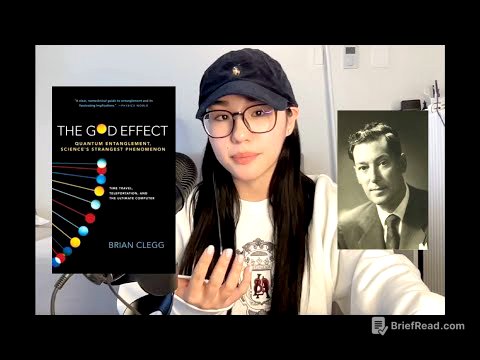TLDR;
This YouTube video by SSC Wallah provides a comprehensive lesson on Time and Work, a crucial topic in quantitative aptitude. The instructor, Pramod Yadav, begins with a lighthearted welcome and quickly transitions into explaining fundamental concepts such as efficiency, the relationship between work, time, and efficiency, and how these concepts apply to solving problems. The video also addresses common queries regarding SSC CHSL exams and offers motivational advice for students.
- Focuses on understanding the relationship between work, time and efficiency.
- Includes practical problem-solving techniques with real examples.
- Offers tips and tricks to solve questions faster.
Introduction and Topic Overview [0:11]
Pramod Yadav welcomes the audience to the session on "Time and Work." He emphasizes the importance of marking attendance and expresses his hope that everyone is doing well. He mentions that the class is meeting after a week, and they have crossed many milestones in terms of completed chapters, including Percentage, Ratio Proportion, and Profit and Loss. Today's focus is on Time and Work.
Importance of Previous Lessons and CHSL Updates [2:27]
Pramod requests viewers to watch previous lessons to understand the interconnectedness of topics in arithmetic. He addresses queries about the CHSL form, stating that the official notification for SSC CHSL 2022 will be released on December 6, 2022, which will provide details on any changes in the pattern or syllabus. He encourages students to prepare diligently, regardless of their current age or eligibility, emphasizing that it's never too late or too early to start.
Basics of Time and Work: Efficiency [9:26]
The discussion shifts to the core concepts of Time and Work, starting with efficiency. Efficiency is defined as work capacity, and the fundamental formula, Work = Efficiency × Time, is introduced. The instructor explains that if time is considered a unit, then efficiency equals the work done. He also defines efficiency as the rate of doing work or the work done in unit time.
Relationship Between Efficiency and Time [13:44]
Pramod uses the example of two friends, Ravi and Rahul, to illustrate the relationship between efficiency and time. Ravi understands a topic in 3 hours, while Rahul takes 4 hours. This demonstrates that Ravi has better efficiency because he takes less time. The instructor explains that if work is constant, efficiency is inversely proportional to time. If the efficiency ratio is 4:3, the time ratio will be 3:4.
Efficiency and Wages [18:10]
The video explains that wages are directly proportional to efficiency when the time period is constant. If time is not constant, wages are divided in the ratio of work done (Efficiency × Time). An example is given to illustrate how wages are divided based on the efficiency ratio when the time period is constant.
Formula Introduction: M1D1H1/W1 = M2D2H2/W2 [20:50]
Pramod introduces the formula M1D1H1/W1 = M2D2H2/W2, where M represents the number of men, D represents the number of days, H represents the number of hours, and W represents the amount of work. This formula is used to solve problems involving different amounts of work done by different numbers of people over different periods.
Problem Solving: Basic Example [22:09]
The instructor begins solving problems, starting with a basic example: A does a work in 10 days, and B does the same work in 40 days. How much time will both take to complete the work together? He first explains the unitary method and then introduces a faster method using LCM (Least Common Multiple) to consider the work done.
Problem Solving: Involving Three People [29:04]
A more complex problem is introduced: A does a work in 15 days, B in 12 days, and C in 20 days. How much time will all three take to complete the work together? The LCM method is used to find the total work, and the combined efficiency of A, B, and C is calculated to find the time taken to complete the work together.
Problem Solving: Finding Individual Time [31:30]
The next problem involves finding the time taken by an individual to complete a work: A + B together can complete a work in 4 days, and A alone takes 10 days. How much time will B take to complete the work alone? The LCM method is used to find the total work, and the individual efficiency of B is calculated to find the time taken by B alone.
Problem Solving: A+B, B+C, C+A Together [33:43]
A more complex problem is presented: A + B together can complete a work in 10 days, B + C in 12 days, and C + A in 15 days. The task is to find the time taken by A + B + C together and the time taken by A, B, and C individually. The LCM method is used to find the total work, and the individual efficiencies are calculated using a series of equations.
Problem Solving: Fraction of Work Left [40:45]
The instructor tackles a problem where A can do a work in 36 days and B in 32 days. They work together for 12 days, after which A leaves. The question is to find the fraction of work left. The LCM method is used to find the total work, and the amount of work done in 12 days is calculated. The remaining work is then expressed as a fraction of the total work.
Problem Solving: Finding B's Time Alone [47:23]
A problem is presented where A + B together can do a job in 40 days, and A alone can do it in 72 days. The task is to find how much time B alone will take to complete the job. The LCM method is used to find the total work, and the individual efficiency of B is calculated to find the time taken by B alone.
Problem Solving: Combined Work with Three People [50:14]
The video addresses a problem where A can do a piece of work in 9 days, B in 18 days, and C is involved in another way. The goal is to find the time taken by all three together. The LCM method is applied to determine the total work, and the combined efficiency is used to calculate the time taken by all three working together.
Problem Solving: Painting a House [51:30]
The instructor presents a problem about painting a house: A can paint a house in 55 days, and B in 66 days. With C's help, they complete it in 12 days. The task is to find how much time C alone will take to do the job. The LCM method is used to find the total work, and the individual efficiency of C is calculated to find the time taken by C alone.
Problem Solving: Working Together and Finding B's Time [54:33]
A problem is introduced where A + B can do a job in 40 days, B + C in 36 days, and all three together in 24 days. The task is to find how many days B alone will take to do the job. The LCM method is used to find the total work, and the individual efficiency of B is calculated to find the time taken by B alone.
Problem Solving: Reducing a Job Together [58:33]
The instructor presents a problem where A can reduce a job by 50% in 16 days, and B can do another quarter of the job in 24 days. The task is to find how much time they will take to reduce 3/4 of the job working together. The LCM method is used to find the total work, and the combined efficiency is used to calculate the time taken to complete 3/4 of the work.
Problem Solving: Leaving After Few Days [1:01:29]
A problem is introduced where A and B start working together, but A leaves after a few days, and B completes the remaining work in 23 days. The task is to find after how many days A left. The LCM method is used to find the total work, and the amount of work done by B in the last 23 days is calculated. The remaining work is then divided by the combined efficiency of A and B to find the number of days they worked together.
Problem Solving: A Leaves and Work Completed in 24 Days [1:05:48]
The instructor presents a problem where A and B start working together, but after a few days, A leaves, and the whole work is completed in 24 days. The task is to find after how many days A left. The amount of work done by B in 24 days is calculated, and the remaining work is divided by A's efficiency to find the number of days A worked.
Problem Solving: A, B, and C Working Alone [1:10:13]
A problem is introduced where A, B, and C can do any work alone in 50, 75, and 20 days, respectively. All three work together for 4 days. The task is to find how much time will it take to complete the remaining work. The LCM method is used to find the total work, and the amount of work done in 4 days is calculated. The remaining work is then divided by the combined efficiency of A, B, and C to find the time taken to complete the remaining work.
Problem Solving: A+B and B+C Working Together [1:13:37]
The instructor presents a problem where A + B can complete a work in 12 days, and B + C can do it in 16 days. A works for 5 days, B for 7 days, and C finishes the remaining work in 13 days. The task is to find how much time B alone can complete the work. The LCM method is used to find the total work, and the individual efficiencies are calculated using a series of steps.
Problem Solving: Before Completion [1:21:29]
A problem is introduced where A can complete a work in 24 days, B in 30 days, and C in 40 days. A and B start working together, but A leaves 4 days before the completion of the work. The task is to find the total time taken to complete the work. The LCM method is used to find the total work, and the amount of work done by C in the last 4 days is calculated. The remaining work is then divided by the combined efficiency of A, B, and C to find the time taken to complete the remaining work.
Problem Solving: Working Together for Three Days [1:25:17]
The instructor presents a problem where A can complete a work in 10 days, and B in 12 days. A and B work together for 3 days, after which B leaves, and A continues for 2 more days. C then joins, and the work is completed in 2 days. The task is to find how much time C alone will take to complete the work. The LCM method is used to find the total work, and the individual efficiency of C is calculated to find the time taken by C alone.
Problem Solving: A and B Working Together [1:29:26]
A problem is introduced where A + B can finish a work in 4 days. B takes 6 days more than A to finish the work alone. The task is to find how many days A alone will take to finish the work. The instructor suggests using the options to satisfy the conditions and avoid forming a quadratic equation.
Problem Solving: A and B Working Together with C [1:32:33]
The instructor presents a problem where A and B can do a piece of work in 5 days, and A can do it in 7 days less than B. The task is to find how much time A alone will take to complete the work. The instructor uses the given information to set up equations and solve for the unknown variable.
Problem Solving: Sharing Wages [1:35:41]
A problem is introduced where A, B, and C complete a work together in 3 days and are paid ₹1848. A and B's combined efficiency is given, and the task is to find C's share. The instructor explains that wages are distributed based on efficiency ratios and calculates C's share accordingly.
Problem Solving: P, K, and R Earning Money [1:37:35]
The instructor presents a problem where P, K, and R are committed to doing a work for ₹6300. P and K start the work and work for 10 days, after which P leaves, and K and R complete the work. The task is to find K's share. The instructor uses the LCM method to find the total work and calculates the amount earned by each person based on their efficiency and the time they worked.
Problem Solving: Ratio of Efficiency [1:44:05]
A problem is introduced where the ratio of the efficiency of P, K, and R is given, and they work for 13, 15, and 19 days, respectively, earning ₹8550. The task is to find the wages of P for 7 days, K for 9 days, and R for 11 days. The instructor explains that wages are calculated in proportion to the work done and calculates the wages accordingly.
Problem Solving: Three Persons and Wages [1:52:29]
The instructor presents a problem where three persons are given ₹1200. The first person does the work in 8 days, the second in 12 days, and the third helps them complete it in 4 days. The task is to find the share of the third person. The instructor uses the LCM method to find the total work and calculates the share of each person based on their efficiency.
Problem Solving: Men and Women [1:55:19]
A problem is introduced where 3 men or 4 women can complete a job in 120 days. The task is to find how many days 5 men and 16 women will take to complete the job. The instructor sets up an equation based on the given information and solves for the unknown variable.
Problem Solving: Men and Days [1:58:15]
The instructor presents a problem where 45 men can complete a work in 20 days. After some days, 15 men leave, and the remaining work is completed in 24 days. The task is to find after how many days the 15 men left. The instructor sets up an equation based on the given information and solves for the unknown variable.
Problem Solving: Men and Food [1:58:56]
A problem is introduced where there is sufficient food for 760 soldiers for 44 days. After 31 days, 240 soldiers leave. The task is to find for how many extra days the remaining food will last for the remaining soldiers. The instructor sets up an equation based on the given information and solves for the unknown variable.
Problem Solving: Soldiers and Food Consumption [2:00:48]
The instructor presents a problem where there is sufficient food for 2400 soldiers for 60 days, with each soldier getting 750 grams of millet every day. After 43 days, 900 soldiers leave, and the remaining soldiers increase their consumption to 850 grams per day. The task is to find for how many days the remaining food will last. The instructor sets up an equation based on the given information and solves for the unknown variable.
Problem Solving: Carpenters and Chairs [2:03:19]
A problem is introduced where 30 carpenters can make 750 chairs in 12 days working 9 hours a day. The task is to find how many days 24 carpenters will take to make 915 chairs working 6 hours a day. The instructor uses the formula M1D1H1/W1 = M2D2H2/W2 to solve the problem.
Problem Solving: Men and Time [2:11:15]
The instructor presents a problem where x men can complete a work in 55 days. If 6 more men are included, it takes 11 days less. The task is to find the value of x. The instructor sets up an equation based on the given information and solves for the unknown variable.
Problem Solving: Bilal's Work [3:18:35]
The instructor presents a problem where A can do a piece of work in 6 days, and B is faster than A. The task is to find how much time Bilal will take to complete the remaining work. The instructor uses the given information to set up equations and solve for the unknown variable.
Problem Solving: A, B, and C Working Together - Last Question [3:21:10]
The instructor presents the last question of the session, where A takes three times as long as B + C together to complete a work, and B takes two times as long as A + C together. All three can finish the work in 10 days. The task is to find how much time A alone will take to complete the work. The instructor uses the given information to set up equations and solve for the unknown variable.


![[자막뉴스] "수능 끝나고 사촌오빠가 저를.."강간범 몰린 남성의 '알리바이' (2023.12.31/MBC뉴스)](https://wm-img.halpindev.com/p-briefread_c-10_b-10/urlb/aHR0cDovL2ltZy55b3V0dWJlLmNvbS92aS9MekxRNm1jOHZVby9ocWRlZmF1bHQuanBn.jpg)

![24 Oras Express: September 11, 2025 [HD]](https://wm-img.halpindev.com/p-briefread_c-10_b-10/urlb/aHR0cDovL2ltZy55b3V0dWJlLmNvbS92aS9wa0d6dTloY2dXdy9ocWRlZmF1bHQuanBn.jpg)
![첫 회부터 전채널 1위하며 시청률 15.5%찍은 술 제조 명가 재벌집 충격적 스토리를 다뤄 화제인 [독수리 5형제를 부탁해!]](https://wm-img.halpindev.com/p-briefread_c-10_b-10/urlb/aHR0cDovL2ltZy55b3V0dWJlLmNvbS92aS9hNG8yV2l3Z01Ddy9ocWRlZmF1bHQuanBn.jpg)



